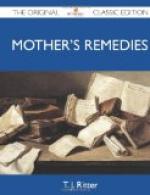From the time of the birth of the head to the delivery of the after-birth the womb must be controlled by the firm pressure of the hand on the abdomen. It is well for the nurse, when the after-birth is separating from the womb to follow the womb, throughout this whole stage, by keeping her hand upon it and if, while the physician is attending to the child, the womb softens and enlarges she should at once notify him. There may be bleeding within the womb. After the womb is empty, friction should be made over the womb whenever it softens at all in order to stimulate the womb to perfect contraction, and it should be kept up at intervals for one hour after the after-birth and membranes have been delivered.
[Obstetrics or midwifery 535]
The child.
The eyes should be washed soon and normal respiration established. If the child does not breathe well, cold water may be sprinkled in the face and chest and if this fails, immersions in hot water at 106 degrees F., and sprinkling with cold water must be resorted to. If necessary, artificial respiration must be given. Slap the child on the back and move the arms up and down by the side a few times, or breathing into the child’s mouth.
Another method.—Face the child’s back, put an index finger in each arm-pit and the thumbs over the shoulders, so that their ends over-lap the collar-bone and rest on the front of the chest, the rest of the fingers going obliquely over the back of the chest. The child is suspended perpendicularly between the operator’s knees. Its whole weight now hangs on the first fingers in the arm-pit; by these means the ribs are lifted, the chest is expanded and inspiration is mechanically produced. The infant is now swung upward till the operative’s hands are just above the horizontal line, when the motion is abruptly, but carefully, arrested. The momentum causes the lower limbs and pelvis of the infant to topple over toward the operator. The greater part of the weight now rests on the thumbs, which press on the front of the chest, while the abdominal organs press upon the diaphragm. By these two factors, the chest is compressed and we get expiration, mechanically. After five seconds the first position is resumed again, and the lungs expand and fill with air. This process may be repeated several times until the breathing seems to be going naturally, and with delicate infants it should be the last resort.
After the breathing has been established the child should be wrapped in a warm flannel with hot water bags or cans near it, and left until the mother has been cared for. Infants at birth are covered with a white greasy substance, vernix caseosa, or cheesy varnish; it is removed by applying olive oil, vaselin or fresh lard, and afterward rubbing the skin gently with a soft cloth. The eyes and mouth should be washed out with pure warm water—or a saturated solution of boric acid, used. Separate squares of soft linen being used for this purpose. If the baby is born too soon or is very small, weak and undeveloped, it should be given an oil bath, only, and then wrapped in cotton wool and kept at a temperature of not less than 80 degrees F., for ten days or two weeks.




